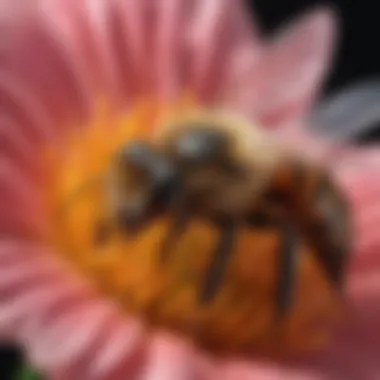Effective Strategies for Safe Bee Removal


Intro
Removing bees from your yard can be a challenging task. While these insects play a vital role in our ecosystem, their presence can cause concern for homeowners, especially if someone in the household is allergic. Understanding how to manage a bee situation safely and effectively is crucial. This guide will provide you with essential information on identifying common bee species, strategies for prevention, and various treatment options you can employ. Whether you are a homeowner or a renter, this article equips you with the knowledge to handle bees responsibly.
Pest Identification
An essential step in managing bees is to accurately identify the species inhabiting your yard. There are several common types, such as honeybees, bumblebees, and carpenter bees. Each has distinct characteristics and behaviors.
Detailed Descriptions of Common Bees
- Honeybees: Typically golden-yellow with black stripes, these bees are social and live in large colonies. They are known for producing honey and forming hives in cavities.
- Bumblebees: Larger than honeybees, bumblebees are usually fuzzy and have a more robust body. They are important pollinators and tend to nest in grass or underground.
- Carpenter Bees: Resembling bumblebees but lacking the hairy appearance, carpenter bees have smooth, shiny abdomens. They make small holes in wood to create nests.
Signs and Symptoms of Infestations
Identifying a bee problem early helps in effective management. Look for the following signs:
- High levels of bee activity around certain areas.
- Visible nests in trees, under eaves, or in wooden structures.
- Hearing buzzing sounds from within walls or ceilings.
If you observe these symptoms, it's time to consider your next steps.
Prevention Strategies
To keep bees from becoming a problem on your property, several preventive strategies can be implemented.
Home Maintenance Tips for Pest Prevention
- Seal Entry Points: Inspect your home for gaps or holes that could serve as entry points for bees. Use caulk or expanding foam to seal these openings.
- Keep Gardens Tidy: Regularly mowing your lawn and removing debris can discourage bees from nesting in your yard.
- Limit Food Sources: Ensure that outdoor food and drink are cleaned up to minimize attractants.
Natural Deterrents and Barriers
Certain natural substances can deter bees from your property.
- Cinnamon: Sprinkling cinnamon around potential nesting areas can effectively repel bees.
- Peppermint Oil: A mixture of peppermint oil and water can be sprayed around your yard to discourage bees from settling.
Treatment Options
When bees have already taken residence, a variety of treatment options can be utilized. Each method has its own advantages and drawbacks.
Overview of Chemical vs. Natural Treatments
- Chemical Treatments: These options often provide fast results. However, they can be harmful to the environment and non-target species. Items like insecticides should be used carefully, following all label instructions.
- Natural Treatments: Many homeowners prefer eco-friendly methods, such as using essential oils or natural sprays. These may take longer to be effective but are safer for the ecosystem.
Step-by-Step Guides for DIY Treatments
- Locating the Nest: Identify where the bees are nesting. Caution is necessary, so consider wearing protective clothing.
- Using Powdered Insecticide: If using a chemical approach, carefully apply the insecticide at dusk when bees are less active.
- Natural Solution Application: For a natural treatment, mix equal parts water and peppermint oil. Spray directly on and around the nest.
- Avoiding Future Infestations: After treatment, follow up with preventive measures to reduce the risk of bees returning.
Always prioritize safety when dealing with bees. If unsure about the process, consider consulting a professional pest control service.
Closure
Successfully managing bees in your yard requires knowledge and caution. This guide serves as a foundation for identifying and removing bees safely and responsibly. By understanding the behavior of different species, implementing prevention strategies, and carefully choosing treatment options, homeowners can effectively address bee-related issues. Through this approach, not only is safety assured for human inhabitants, but the ecological balance can also be respected.
Prelude to Bee Removal
The removal of bees from residential areas is a topic that often requires careful consideration. Bees play a vital role in pollination, which is essential for many plants and crops. However, their presence can sometimes become overwhelming or pose risks to human safety. This guide seeks to explore the nuances of bee removal, emphasizing safe and effective methods while acknowledging the ecological importance of these insects.
Understanding bee removal requires a balance between human needs and the environment. Homeowners may face situations where bees invade their yards, creating a sense of urgency to address the issue. Knowing how to identify bees, understand their behavior, and recognize when removal is necessary forms the foundation of this process. By prioritizing safety and ecological responsibility, individuals can manage bee populations effectively without causing harm.
Benefits of Proper Bee Removal


- Safety: Ensuring that individuals, especially those allergic to bee stings, are protected from potential harm.
- Environmental Impact: Acknowledging the role bees play in agriculture and gardening promotes a more sustainable approach to removal.
- Knowledge: Educating oneself about bee behavior supports better decision-making regarding removal.
"Removing bees should not be a knee-jerk reaction. Understanding them can lead to more effective solutions."
In summary, the discussion around bee removal is not just about eliminating a problem but rather managing it intelligently and responsibly. As we delve deeper into the sections that follow, we will break down the methods, safety precautions, and ethical considerations associated with bee removal, aiming to provide homeowners with comprehensive and actionable insights.
Identifying Bees in Your Yard
Identifying bees in your yard is important for several reasons. First, understanding the types of bees present helps you determine the best method for removal or management. Different species have varying levels of aggression and benefits to the ecosystem. Second, accurate identification ensures you avoid harming non-aggressive bee species that are essential for pollination.
Recognizing bees can also help you detect potential problems early. If you notice a sudden increase in bee activity, it could indicate a nesting site or hive nearby. This knowledge allows you to take proactive measures before the situation escalates. Here, we will explore common species of bees, their distinctive characteristics, and how to differentiate them from wasps.
Common Species of Bees
In residential areas, several bee species are commonly found. The honey bee is one of the most recognizable due to its significance in agriculture and honey production. Bumblebees are also prevalent, known for their large, fuzzy bodies and social behavior. Mason bees and leafcutter bees, while less conspicuous, play crucial roles in pollination.
It's valuable to know these species as each contributes differently to the ecosystem. For example, honey bees can become aggressive if they feel threatened, while bumblebees are generally more docile but can still sting if provoked.
Distinctive Characteristics
Identifying bees involves paying attention to specific traits. Honey bees are medium-sized with a golden-yellow color and black stripes. They are characterized by their smooth bodies and long legs covered in hair, which assist in pollen collection.
On the other hand, bumblebees appear larger and furrier, with varying colors like yellow, orange, and black. Their rounder bodies help distinguish them from other types. Mason bees are smaller and metallic in appearance, usually blue or green, and can be recognized by their long antennae and lack of hair on their legs.
To identify these bees correctly, it can be helpful to observe their behavior. Honey bees typically gather in large groups, while bumblebees may be seen on flowers, collecting nectar or pollen individually.
Differentiating Bees from Wasps
It is crucial to distinguish between bees and wasps, as they serve different roles in the ecosystem. Bees are generally rounder and hairier, which aids in collecting pollen. Their bodies are often more robust and may appear fuzzy.
Wasps, in contrast, have slender, smooth bodies with less hair. They exhibit a more aggressive behavior and can often be found around food. They play a role in pest control, but their presence can be a nuisance.
Here are key differences summarized:
- Body Shape: Bees are round and hairy; wasps are slender and smooth.
- Behavior: Bees are more docile; wasps can be aggressive, especially in groups.
- Nesting Habits: Bees usually create hives; wasps often build nests from paper-like material.
Understanding these distinctions is not only beneficial for safety but also promotes proper management of bees in your yard.
Safety Precautions
When dealing with bees, safety is paramount. Understanding and applying proper safety precautions can prevent accidents and minimize risks involved in the removal process. By prioritizing safety, homeowners can ensure that they address bee presence effectively without putting themselves, their families, or the bees in unnecessary danger.
Personal Protective Equipment
Using personal protective equipment (PPE) is a critical step for anyone dealing with bees. The right gear can minimize the chances of getting stung while you attempt to remove or relocate a hive. Common PPE includes:
- Beekeeping Suit: A full-body suit provides overall protection. Look for suits made from breathable materials for comfort.
- Gloves: Thick gloves will shield your hands. Ensure they extend up the arms for added safety.
- Face Shield or Veil: A veil protects the face from stings. It's essential to maintain visibility while keeping the face covered.
- Sturdy Boots: Footwear should cover your ankles and be made of durable material to prevent stings on the feet.
Using this equipment not only protects you but also instills confidence as you engage with bees more safely.
Avoiding Allergic Reactions
Awareness of allergic reactions is crucial before addressing a bee issue in your yard. Some individuals may have severe allergies to bee venom, which can result in serious health implications.
- Know Your Status: If you or anyone in the household has a history of allergies to bee stings, it is wise to consult a medical professional before proceeding.
- Have Emergency Supplies Ready: If someone is allergic, ensure that necessary treatments, such as epinephrine auto-injectors, are accessible during the removal process.
- Identify Signs of Allergies: Symptoms can include swelling, difficulty breathing, or hives. Being alert to these signs can be lifesaving.
Understanding Bee Behavior
To effectively manage bees, knowledge of their behavior is essential. Bees can be protective of their hives, especially during warmer months and at dusk. Understanding their habits helps in strategizing an appropriate mitigation plan.


- Observation: Take time to observe bees from a distance. Notice when they are most active and how they respond to disturbances.
- Calm Approach: Loud noises and fast movements can escalate bee aggression. Approach the area slowly and calmly to avoid startling them.
- Time Your Actions: The best time for removal is in the early morning or late evening when bees are less active.
- Understand Hive Defense: Bees will defend their hive fiercely. Recognizing this natural behavior is critical before attempting removal.
Always prioritize safety when managing bees in your yard. Knowledge, preparedness, and protective gear are your best allies in creating a safe removal environment.
Effective Removal Techniques
Removing bees from your yard demands a strategic approach. This section highlights the various effective techniques available for safely managing bee populations. The importance of utilizing the right method lies in balancing safety, effectiveness, and ecological considerations.
Employing effective removal techniques ensures not only the removal of the bees but also minimizes potential harm to them and the surrounding ecosystem. Knowing when to use a natural method, chemical solution, or call for professional help can significantly impact the circumstances surrounding a bee removal situation.
Natural Removal Methods
Natural removal methods present an eco-friendly alternative for those looking to manage bees with minimal impact. One of the most popular techniques involves using essential oils. For example, peppermint oil can be an effective deterrent. Mixing it with water in a spray bottle and applying it around the area can make the environment less hospitable for bees.
Another method is to create barriers. Using mesh or screens can help block entrances to areas where bees are nesting. If the bees are in a tree or shrub, simply relocating or trimming back the foliage might encourage them to move elsewhere.
Some homeowners have had success with smoke. Lighting a small amount of sage can create a smoke that bees tend to avoid. However, caution is necessary, as excessive smoke can irritate them.
Overall, these methods require patience and observation. These techniques aim to encourage bees to relocate without causing harm to them or the ecosystem.
Chemical Removal Solutions
Chemical solutions are a more aggressive approach to bee removal. These products are specifically designed to target bee populations. It is crucial to choose a solution that is effective yet minimizes risk to other pollinators.
Products like insecticidal dusts and sprays can be opted for when bees pose an immediate risk. It's important to read instructions carefully and apply the product in the evening when bees are less active. Proper timing is critical to reduce the risk of stings and ensure effectiveness.
Remember to evaluate the required protective measures while using chemical solutions. This may include gloves, long sleeves, and respiratory protection. This approach should be a last resort, as it can harm beneficial insects and disrupt the local ecosystem.
Professional Bee Removal Services
When all else fails, or if the bee population is large or aggressive, professional bee removal services may be necessary. Hiring experts can provide several benefits, particularly in terms of safety and efficacy. Professional beekeepers have the tools, experience, and knowledge to address complex bee situations while ensuring minimal harm to the bees.
These services can assess the situation and determine the best course of action, which might include relocating the hive rather than exterminating it. It is essential to select a reputable service that follows ethical practices, as not all companies have the same level of commitment to preserving bee populations.
"Choosing professionals for removal not only ensures safety but also respects the ecological role of bees."
Preventive Measures
Preventive measures are crucial in managing bee populations in residential areas. Understanding how to deter bees effectively can save homeowners from the complications that arise with unwanted swarms. By adopting proactive strategies, individuals can minimize the likelihood of bees establishing nests or colonies near their properties. This section will discuss specific landscape management practices, home maintenance tips, and natural deterrents that will help mitigate the presence of bees in yards.
Landscape Management Practices
Managing the landscape is one of the most effective ways to prevent bee infestations. The type of vegetation and garden layout can either attract or repel bees. Here are some important practices to consider:
- Select Bee-Friendly Plants Wisely: While many plants provide food for bees, selecting species that do not attract them can be beneficial. Opt for flowers like marigolds and petunias that have lower appeal to bees.
- Maintain a Neat Lawn: Regular mowing and trimming can prevent bees from establishing nests close to home. Wild overgrown areas can serve as ideal habitats for bees and should be controlled.
- Create Barriers: Using fences or hedges can limit bees' access to desirable nesting areas. Ultimately, a well-designed landscape with controlled vegetation can deter bees effectively.
Home Maintenance Tips
Maintaining your home is essential to prevent bees from finding inviting spaces to set up their colonies. Here are several tips to consider:
- Seal Entry Points: Carefully inspect your home for cracks and crevices. Use caulk or expanding foam to close gaps in walls, windows, and doors where bees may enter or build nests.
- Remove Attractants: Be mindful of food and drinks left outdoors. Clean up spills and store food in sealed containers. Also, ensure trash bins are tightly closed to avoid drawing bees.
- Routine Cleaning: Regular cleaning, especially in outdoor spaces, can discourage bees from establishing themselves. This includes gathering trash, leftover food, and any other organic material.
Using Natural Deterrents
Natural deterrents offer a chemical-free way to keep bees at bay. Here are some recommended methods:
- Essential Oils: Certain essential oils like peppermint and citronella can repel bees. Mixing these oils with water can create a spray that you can apply around potential nesting areas.
- Vinegar Solutions: A mixture of vinegar and water can serve as an effective repellent when sprayed around the yard. The strong scent can deter bees from entering specific areas.
- Cinnamon: Dusting cinnamon in areas where bees frequent can create a hostile environment. Bees dislike the smell, which can discourage their presence.
"Preventive measures are integral to maintaining a bee-safe environment. Each step taken towards proactive management can lead to significant reductions in bee visits."


By implementing these preventive measures, homeowners can effectively reduce the chances of bee infestations. Not only do these strategies provide immediate relief, but they also promote long-term management of bee populations in the yard.
Legal and Ethical Considerations
Understanding the legal and ethical implications surrounding bee removal is crucial for homeowners and individuals. This section emphasizes the dual responsibility of ensuring safety while adhering to legal guidelines. Improper removal can lead to legal repercussions, as many regions have regulations safeguarding bee populations to protect biodiversity. Moreover, ethical considerations encourage humane approaches toward bees rather than harmful practices.
Local Regulations on Bee Removal
Local regulations often dictate how and when bees can be removed from residential areas. Different jurisdictions have distinct rules that reflect the community's stance on wildlife protection. For instance, many states in the U.S. classify certain species of bees as protected, making it illegal to harm or destroy their habitats without a permit.
Homeowners should research their specific state and local government laws. Failure to comply can result in penalties, including fines and mandatory restitution. Additionally, local beekeeping associations can provide valuable information regarding regulations in your area.
"It's essential to be informed about the laws regarding wildlife in your locality. Ignorance is not an excuse when dealing with environmental laws."
Before taking any action, consider contacting local authorities or checking websites dedicated to wildlife regulations for guidance.
Ethical Beekeeper Practices
Ethical beekeeper practices promote a respectful coexistence with bee populations. This includes methods that prioritize the well-being of bees while addressing human concerns. Ethical approaches involve minimizing harm and considering the ecological impact of bee removal actions.
A few practices to observe include:
- Relocation Over Elimination: Whenever possible, relocate hives instead of exterminating them. This not only preserves the colony but also supports local biodiversity.
- Engaging Professionals: Employ certified beekeepers or pest control experts who specialize in humane removal techniques. They can ensure safety for both humans and bees.
- Community Education: Engage in or support community programming that educates others about the importance of bees. Awareness can reduce fear and hostility towards these insects.
By adopting these ethical practices, individuals contribute positively to local ecosystems and promote a balanced approach to pest management.
Case Studies and Success Stories
Case studies and success stories play a vital role in understanding the practical applications of bee removal techniques. They provide real-world insights into how various strategies have been executed successfully, offering valuable lessons for homeowners and professionals alike. By examining specific instances where bee removal was carried out, readers can glean ideas on methods that are effective and safe. These examples also illustrate potential challenges and solutions, which can prepare individuals for their own bee removal endeavors.
Moreover, these narratives bridge the gap between theory and practice, allowing readers to relate to the experiences of others. In an era where environmental considerations are paramount, understanding successful interventions can guide responsible decision-making regarding bee management. The following sections delve into the personal experiences of homeowners and insights from professionals in bee removal services.
Homeowners' Experiences
Homeowners often find themselves facing the unexpected challenge of bee infestations. One typical experience noted by many is the moment they discover bees establishing a hive in their yard or home. Many shared feelings of alarm accompanied by a desire to protect their family and property while also considering the ecological role of bees.
In one case, a family in suburban Chicago found a swarm of honey bees settling in their backyard. Initially, they panicked, fearing an attack. After researching, they learned about the benefits of bees and decided to take a different approach. They opted for a local beekeeper's assistance rather than extermination, leading to the safe relocation of the hive. This decision not only preserved bee populations but also fostered a positive relationship with the local ecosystem.
Another homeowner from Austin described how small changes in landscape management practices helped deter bees while minimizing risks. They trimmed back overgrown bushes, removed unused garden debris, and planted bee-repelling plants like citronella. This proactive approach not only reduced bee sightings but also enhanced their outdoor space.
These stories share common threads of concern, education, and eventual resolution. They highlight the importance of assessing the situation accurately, exploring alternatives, and understanding the local area’s regulations and ecological significance of bees.
Professional Insights
Professionals specializing in bee removal often offer a wealth of knowledge based on their extensive fieldwork. Their experiences highlight the methods, tools, and practices that lead to successful bee management outcomes. One professional, a licensed beekeeper from California, emphasized the importance of identifying the species before any removal attempt. By recognizing whether the bees are honey bees, bumble bees, or another species, effective and safe removal strategies can be developed.
Additionally, professionals often advocate for communication with the property owner regarding the ecological impact of bees. This dialogue fosters an understanding of the necessary balance between safety and environmental stewardship. For example, one pest control expert shared a case where a business had a bee problem on their rooftop. Instead of destroying the hive, the team worked with a local beekeeper to safely relocate it, turning an annoyance into an educational opportunity for the nearby community.
A critical insight from a pest management specialist included a cautionary tale about inexperienced DIY removal attempts. In one case, a homeowner attempted chemical spraying without adequate knowledge. The results were unfortunate, leading to harm to non-target species and creating an unsafe environment for their family.
Overall, insights from professionals can guide homeowners in making informed choices, prioritizing safety, and understanding the complexities involved in bee removal. Their experiences serve as instructive examples for those navigating similar situations.
Epilogue
The conclusion of this guide addresses the significance of effective bee management and the various elements that come into play when dealing with bees in residential areas. This article emphasized that bees, while essential for our ecosystem, can pose challenges when they inhabit our yards. The content explored safe removal techniques, preventive measures, and the legal implications one might face. Recognizing the balance between respecting the benefits of bees and maintaining a comfortable living environment has crucial implications for homeowners.
Summary of Key Points
In summary, the critical aspects covered include:
- Understanding of Bee Behavior: Acknowledging the instinctive nature of bees helps in managing encounters safely.
- Identification and Removal Techniques: Knowing what species inhabit your yard and how to remove them effectively without harm is essential.
- Preventive Measures: Implementing strategies to discourage bee nesting can reduce the likelihood of problems in the future.
- Legal and Ethical Considerations: Every region may have different laws regarding bee removal, and adhering to these regulations is fundamental.
"Handling bees with care not only ensures safety but also promotes ecological balance and respect for nature."
Final Thoughts on Bee Management
Effectively managing bees in your yard is a multifaceted task. It requires understanding the significance of bees in our ecosystem, acknowleding their role in pollination, and taking measured steps to achieve peaceful cohabitation or removal. Homeowners should prioritize safety, not only for themselves but also for the bees.



